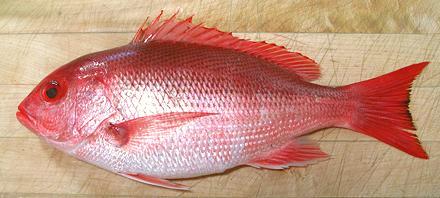 [Lutjanus vivanus | similar L. campechanus
(Northern Red Snapper (Gulf of Mexico)) | L. purpureus (Southern
Red Snapper (Caribbean))]
[Lutjanus vivanus | similar L. campechanus
(Northern Red Snapper (Gulf of Mexico)) | L. purpureus (Southern
Red Snapper (Caribbean))]
This Snapper is found along the coast of the Western Atlantic, from North Carolina to São Paulo, Brazil, but is most common around the Antilles and Bahamas. It can get up to almost 33 inches long and 18 pounds but the photo specimen was 12-3/4 inches and weighed 1 pound 1-7/8 ounces. It looks almost identical to the Pacific Red Snapper but its cooking properties are a little different. There have been reports of ciguatera poisoning from eating this fish from tropical reef environments. Silk Snapper is Red List rated NE (Not Evaluated) but is not considered threatened.
More on Snapper Family.
Silk Snapper flesh is so tender it is unsuitable for wet cooking, and rather than flaking apart, it just sort of crumbles on the plate. The flavor is rather light and will not deeply offend people who like their fish "white and lite". There is a dark band down the center under the skin that is both wide and deep, but it doesn't taste much stronger than the white meat.
The photo specimen was purchased from a local Philippine market here in Los Angeles for 2014 US $3.99 per pound. The same market usually asks $6.99 per pound for Pacific Red Snapper.
Cooking: This fish can be pan fried with a light powdering of rice flour, skin on if you start them skin side up, then pat the fillet down flat after turning. Because the skin doesn't shrink strongly this fish can be baked whole. If desired the skin can be easily slipped off after baking. Skinless fillets are rather fragile but can be poached if small and carefully handled. For poaching, fillets must be skinned, because, though the skin shrink isn't strong, the flesh is extremely weak and skin shrink will roll the fillet up into a tube.
Scales: The scales are of medium size and strong, but scrape off rather easily with only moderate flying about. Scrape gently on the belly, it is thin and liable to break open. Unlike most fish, a fair amount of the red color is in the scales so it'll be a much lighter red when they are scraped off.
Cleaning: This fish presents no particular problems in cleaning. The esophagus is a bit tough so you may want to cut it with kitchen shears. The gills pull fairly easily with long nose pliers.
Fillet: This is a very easy fish to fillet with easy to follow bone structure. There should be almost no flesh left behind. I usually remove the head before filleting. Tilt the knife to get under the gill covers to get as much flesh as possible. There will be a couple small bones you'll need to cut with kitchen shears, and then the backbone. When filleting, treat it gently and minimize bending the flesh as it is very tender. For full method see our Cleaning and Filleting Round Fish page.
When you get to the rib cage, just cut the ribs away from the backbone with kitchen shears and pull them from the fillet with long nose pliers. They pull easily, but hold the flesh in place with your fingers so it doesn't tear apart. There is a short row of substantial centerline spines which need to be pulled for the length of the body cavity. Pull straight forward, and, again, hold the flesh in place with your fingers or it will tear.
Skin: The skin has no strong or "off" flavor and shrink is quite moderate so baking whole fish works well, even without slashes through the skin for moderate sized fish. The skin is thin, but fairly strong, so fillets can be skinned fairly easily using the long knife and cutting board Method, but keep the angle of the knife quite shallow. You will loose a small lump of flesh from the skirt, which can be used for some other purpose. The skins can be included with heads, bones and fins for making stock.
Yield: A 1 pound 1-7/8 ounce fish yielded 9-1/8 ounces of skin-on fillet (51%), and 8-1/2 ounces skinless (48%).
Stock: The head, bones and fins make a nearly clear soup stock that is very mild in flavor, perhaps even too mild. you can toss in the skins for better yield and perhaps a little more flavor. There is little oil, but what there is should be removed - use your gravy separator. For details see our Fish Stock page.
sf_snapprz 080607 - www.clovegarden.com